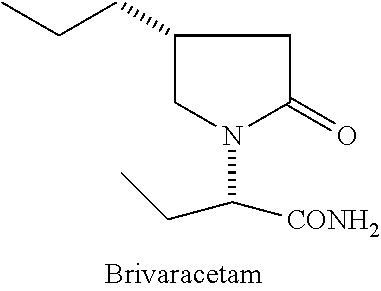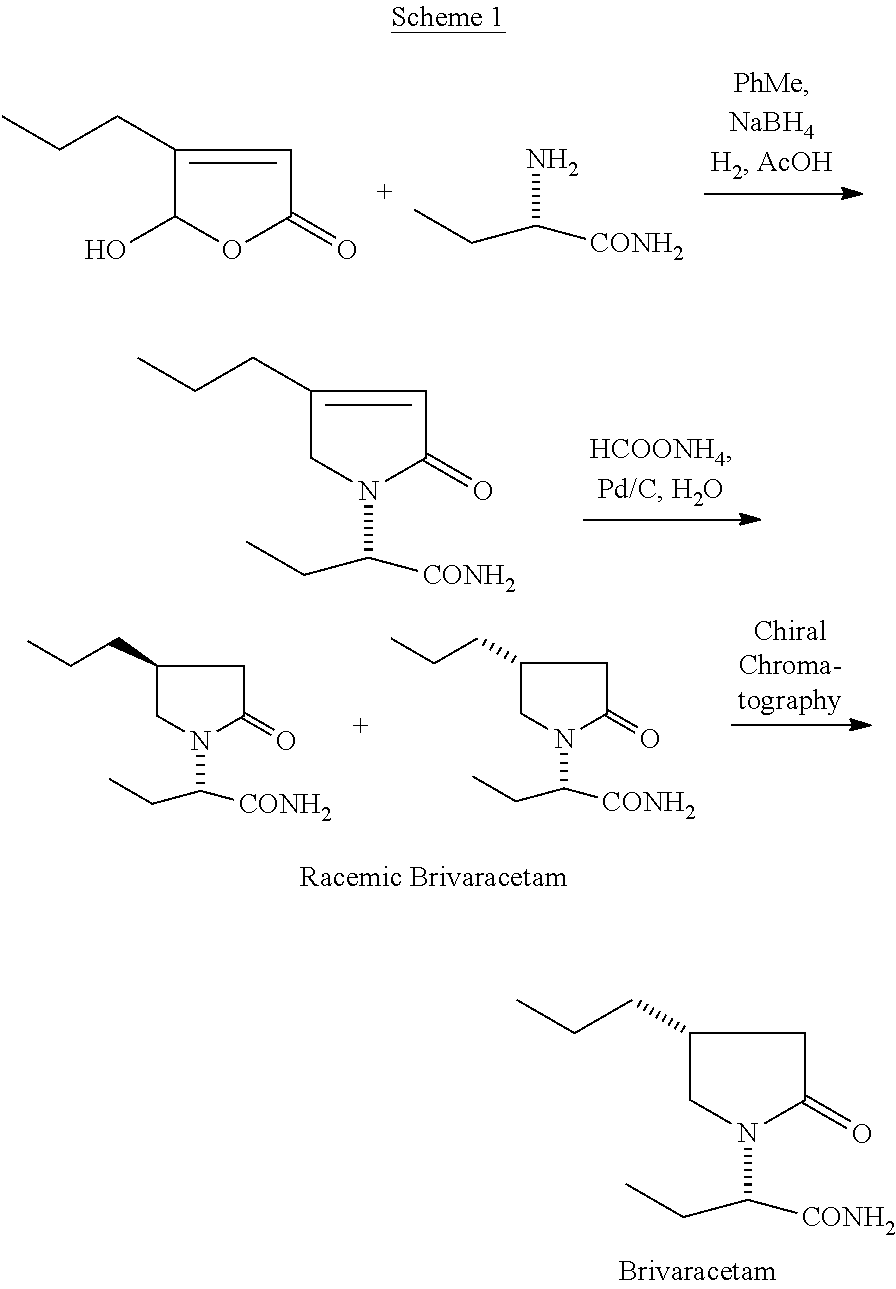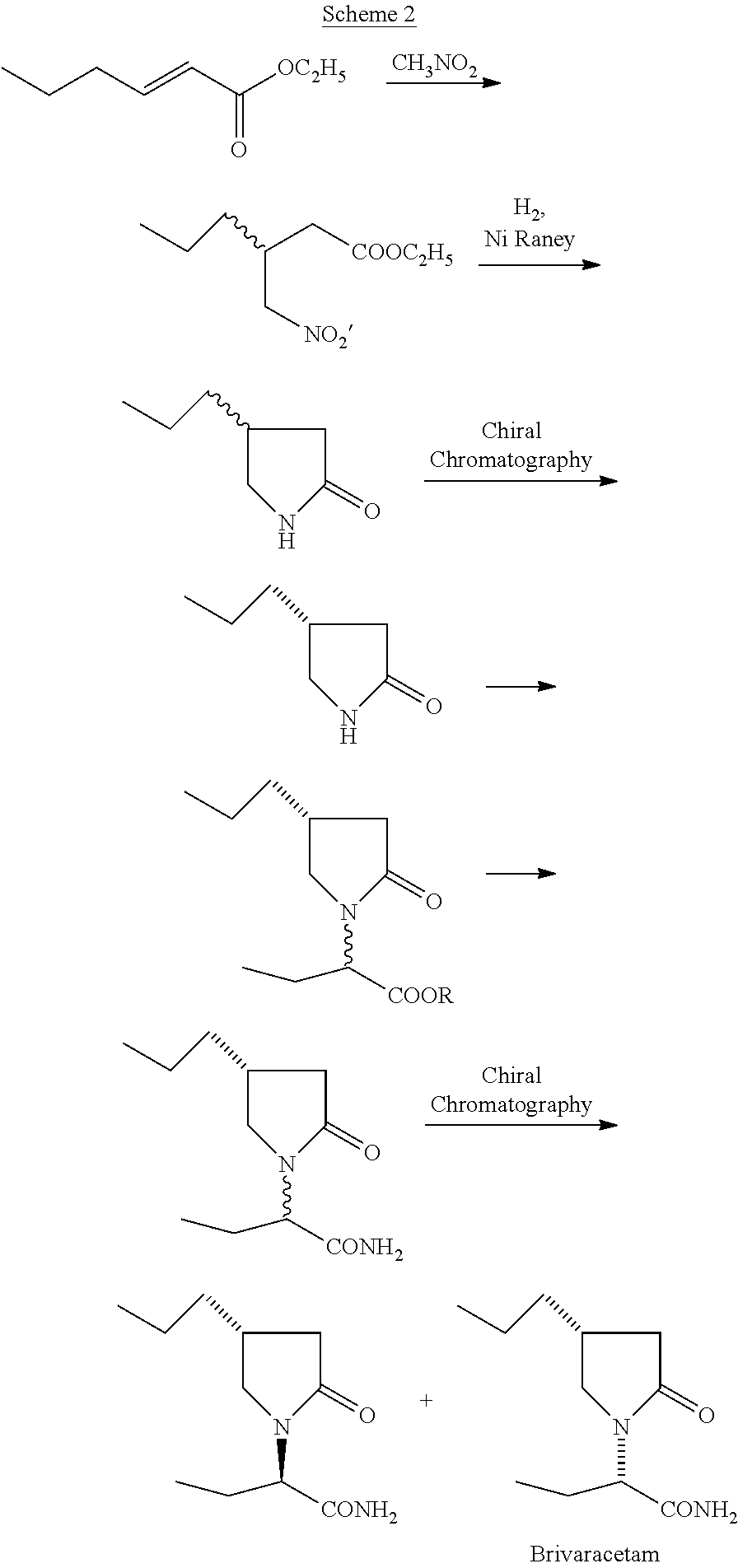Process for preparing Brivaracetam
a technology of brivaracetam and process, which is applied in the field of improved process for the preparation of brivaracetam, can solve the problems of i) giving (i) in poor yield (32%), and achieve the effect of high yield and good yield
- Summary
- Abstract
- Description
- Claims
- Application Information
AI Technical Summary
Benefits of technology
Problems solved by technology
Method used
Image
Examples
example 1
on of 4-propylpiperidine-2,6-dione (V)
[0047]A suspension of n-butyraldehyde (25 gm, 0.35 mol), 2-cyanoacetamide (58.5 gm, 0.70 mol), and potassium hydroxide (0.75 gm, 0.013 mol) in water (175 mL) was stirred at 25° C. to 30° C. for 5 to 6 hours. To the reaction mixture was added 216 mL of 36% HCl and heated to 95° C. to 100° C. to get a clear solution. The solution was stirred at this temperature for 12 to 15 hours. After completion of the reaction (monitored by TLC), the reaction mixture was extracted with 3×100 mL methyl tert-butyl ether. The organic layers were pooled, dried over anhydrous sodium sulfate, and concentrated to obtain a crude residue of 3-propylpentanedioic acid. To the crude residue was added urea (25 gm, 0.42 mol) and heated to 140 to 150° C. The reaction mass was stirred at this temperature for 4 to 5 hours. The reaction mixture was cooled to 90° C. and 200 mL water was added. The reaction mixture was further cooled to 5 to 10° C. and stirred for about 30 mins. T...
example 2
on of (RS)-3-(2-amino-2-oxoethyl) hexanoic acid (VI)
[0048]Sodium hydroxide (10.5 gm, 0.26 mol) was added to a suspension of 4-propylpiperidine-2,6-dione (V) (34.0 gm, 0.22 mol) in water (150 mL) at 25° C. to 30° C., and stirred for 10 mins to get a clear solution. The solution was heated to 50° C. to 55° C. and stirred for 30 mins. After completion of the reaction (monitored by TLC), the reaction mixture was cooled to 0° C. to 5° C. and pH adjusted to 1.0 with 36% HCl. After stirring for 30 mins, the precipitated product was filtered, washed with 100 mL of cold water and dried to yield (RS)-3-(2-amino-2-oxoethyl) hexanoic acid (VI). Yield: 35.3 gm (93%), M.R: 128-130° C., Purity by HPLC: 99.5%.
example 3
on of (S)-3-(2-amino-2-oxoethyl) hexanoic acid (II)
[0049](RS)-3-(2-amino-2-oxoethyl) hexanoic acid (VI) (50.0 gm, 0.28 mol) was dissolved in a mixture of 500 mL chloroform and 18 mL ethanol. The solution was heated to 50° C. Portionwise, S-(−)-1-Phenylethylamine (35.0 gm, 0.28 mol) was added and the reaction mass was stirred for 30 mins at 50° C. The reaction mass was cooled to room temperature and stirred overnight.
[0050]The precipitated salt was filtered. The filtrate was kept aside for recovering the unwanted R-isomer (IV). The precipitated salt was added to 100 mL water and pH adjusted to about 13.0 using 40% solution of sodium hydroxide. The reaction mass was extracted with 3×50 mL chloroform from which S-(−)-1-Phenyl ethyl amine was recovered. The aqueous layer was cooled to 0-5° C. and its pH was adjusted to 2.0 using 36% HCl. After stirring for 20 mins, the precipitated solid was collected to obtain (S)-3-(2-amino-2-oxoethyl) hexanoic acid (II). Yield: 22.5 gm (40%), Purity ...
PUM
| Property | Measurement | Unit |
|---|---|---|
| temperature | aaaaa | aaaaa |
| temperature | aaaaa | aaaaa |
| temperature | aaaaa | aaaaa |
Abstract
Description
Claims
Application Information
 Login to View More
Login to View More - R&D
- Intellectual Property
- Life Sciences
- Materials
- Tech Scout
- Unparalleled Data Quality
- Higher Quality Content
- 60% Fewer Hallucinations
Browse by: Latest US Patents, China's latest patents, Technical Efficacy Thesaurus, Application Domain, Technology Topic, Popular Technical Reports.
© 2025 PatSnap. All rights reserved.Legal|Privacy policy|Modern Slavery Act Transparency Statement|Sitemap|About US| Contact US: help@patsnap.com



